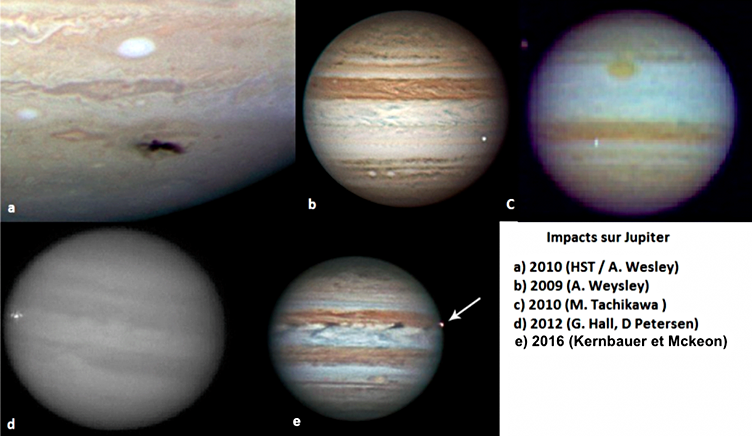Project “IMPACTS”Impacting Meteoroids in giant Planet Atmospheres CharacTerization Survey
PI: Kévin BAILLIÉ (IMCCE, Observatoire de Paris, CNES)
Co-I: François COLAS (IMCCE, Observatoire de Paris, CNRS)
Marc Delcroix (station de planétologie des Pyrénées)
Characterization of the meteoroid flux across the Solar system.
(Observation des impacts météoritiques à la surface des planètes géantes et caractérisation du flux météoritique dans le Système solaire)
Context
The meteoroid flux is only well known in the Earth environment (Earth and Moon). However, modeling giant planet subsystems requires a more precise estimation of the meteoroid flux in the outer solar System: this is in particular necessary for the sudy of rings survival and outer planet satellites formation.
Aims
For the past few years, amateur and professionnal observers were able to detect a few impact flashes in the upper layers of Jupiter’s atmosphere, due to (> 10 m)-sized meteoroids. In addition, we estimate that the resulting aerosols deposited in the upper layers of the giant planet atmospheres remain visible for a few days/weeks. This will allow possible indirect observations of such impacts even a few days after the events. Based on the observations at such flashes and aerosol remains at the surface of the Solar system giant planets, we intend to estimate the meteoroid flux at Jupiter and Saturn, and model this flux as a function of the distance to the Sun.

Methods
We will organize an observational survey of Jupiter’s and Saturn’s surface in order to estimate the flux of meteoroids at their locations and the size of the impactors. While a few such events were recorded by chance in the last few years, we expect that a thorough continuous observation campaign of Jupiter’s and Saturn’s surface will allow to determine the meteoroid flux at 5.2 and 9.1 AUs. It appears that such impacts release aerosols in the planet atmsosphere that are able to remain visible from Earth for a few weeks with a Methane filter. Therefore, repeating observations every month will provide a good estimation of that flux.
Observations
We will observe Jupiter and Saturn from the T1M at Pic du Midi (PI: François Colas, who is also co-I in this project), the 120 cm and 152 cm telescopes at observatoire de Haute-Provence. Occasional former planetary missions data may be used to characterize impactors and calibrate impactor sizes from ground observations. In addition to observing by ourselves (Baillié, Colas, Birlan), we will coordinate with the usual IMCCE observation programs (satellites, GaiaFun…) to obtain regular data of Jupiter and Saturn between our periods of observations. Finally, we will create a team of professional and amateur observers to increase our coverage of these events over at least half a period of Jupiter.
Consequences
A precise estimation of the meteoroid flux at various planet locations will allow to derive a model of the present flux as a function of the distance to the Sun. Such a model will help constrain the scenarios of formation of the giant planet rings and satellites, and in particular their age: it may help calibrate crater counting methods for the outer planet icy satellites and quantify the ballistic transport inside Saturn’s rings.
Funding proposals
- Europlanet NA1 Workshop Proposal (accepted)
- “ePARADISE” ANR funding (under review): Dedicated high dynamic IR camera at Pic du Midi
- CS-OBSPM and INSU fundings (in prep.): PhD thesis subject (adv. Colas & Baillié)
Kévin Baillié is a postdoctorate researcher at IMCCE – Paris Observatory, funded by a CNES fellowship. During his PhD in UCF (Orlando, USA), he worked Cassini UVIS data to characterize and model Saturn’s rings and satellites. He is also a co-I of the “ePARADISE” project that aims at developing an Infrared Adaptive high dynamic camera for the T1M telescope at Pic du Midi (French Pyrénées).
François Colas, is a research director at CNRS, PI of the FRIPON project and of the T1M telescope at Pic du Midi. His expertise in solar system objects observations will be a great benefit for the organization of the observation campaign and the formation of amateur astronomers in the frame of this survey.
Marc Delcroix (station de planétologie des Pyrénées), is responsible of the DeTeCt program, expert in Jupiter flash detections.
Last update Friday 19 June 2020